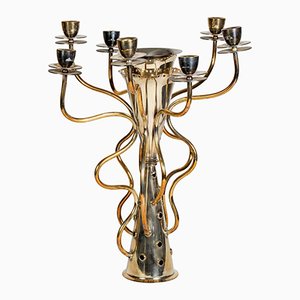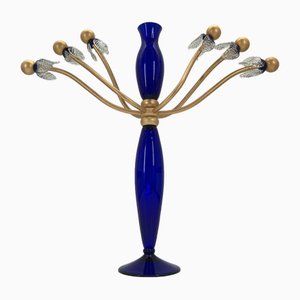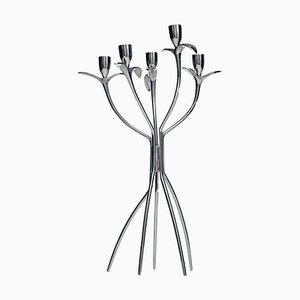
Designer and glass artist Bořek Šípek was born in Prague in 1949. At the age of fifteen, Šípek was orphaned and subsequently raised by the famous Czech glass artist René Roubíček (b. 1922). With Roubíček as his mentor and guardian, Šípek gained an early appreciation for glass, which ultimately led to a successful career in the field. Today, he is internationally known for his whimsical and colorful neo-baroque glass realizations.
Šípek began his studies in furniture construction in Prague. Following the Soviet invasion of then Czechoslovakia, he immigrated to Germany in 1968. While in Germany, Šípek continued his studies in cabinetry, later going on to study architecture at the University of Applied Arts in Hamburg (he graduated in 1974) as well as philosophy at the Technical University in Stuttgart. In 1979, he earned a Doctorate in Architecture from the Technical University of Delft.
Šípek moved to Amsterdam in 1983, where he established his own architecture and design studio, Aletrego. By the mid-eighties, he had caught the eye of Italian design brand Driade, and Šípek began designing furniture, cutlery, glass vases, lamps, and other home accessories for the company. Šípek became one of the brand's core designers alongside contemporaries Antonia Astori (b.1940), Philippe Starck (b. 1949), and Oscar Tusquets (b.1941). His new collaboration with Driade helped promote his designs and earned him international acclaim.
Sometime in the late 1980s, Šípek, glass technologist Libor Fafala, and master glassblower Petr Novotný founded the Ajeto glass factory in the Czech Republic. The company’s goal was to preserve traditional Bohemian glassblowing. Šípek’s Czech identity was very much tied to his artistic aesthetic, and his glass pieces played a pivotal role in saving the glass tradition in his homeland after the Velvet Revolution—a period of rapid transformation and uncertainty. Šípek was also appointed court architect of Prague Castle by former Czech president Václav Havel—a position he held from 1990 to 2003.
Šípek has designed pieces for companies such as Alessi, Cleto Munari, Maletti, Sawaya & Moroni, Vitra, Scarabus, Wittmann, Swarovski, Leitner, Quartet, Sèvres, Saint-Gobain, and Rosenthal. His pieces are highly sensual and sculptural. Notable design include the Bambi Chair (1983), Jansky Chair (1986), the rattan Liba Chair (1988), Maletius Chair (1992), the Paris boutique of fashion designer Karl Lagerfeld (1995), various lighting fixtures for the Skoda stand at Volfsburg’s World EXPO (2000), Olga Vase (2001), and a chandelier for the Beograd Opera House (2005).
Over the course of his career, Šípek taught design at universities in Hannover, Essen, Vienna, and Prague, and in 2005 he became the Dean of the Faculty of Architecture at the Technical University in Liberec, Czech Republic. He was honored with multiple awards, including the Kho Liang Ie Prize for Design (Netherlands, 1989); the title of La Croix Chevalier by the Order of Arts and Letters (L’Ordre des Arts et des Lettres) from the French government (1991); and the Prince Bernhard Fonds Prize for Architecture and Applied Arts (Netherlands, 1992).
Šípek passed away in February 2016 at the age of 66 in Prague.



